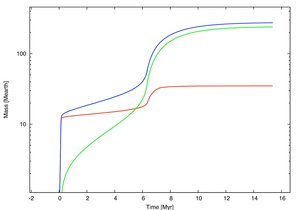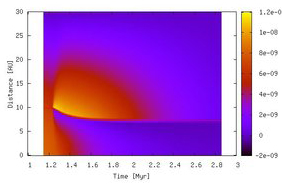Giant planet formation
Contact: C. Mordasini, K. Dittkrist, H. Klahr, Y. Alibert (University of Bern), W. Benz (University of Bern and external scientific member MPIA)
Within the standard paradigm for giant planet formation, the core accretion-gas capture model, a giant planet forms in two steps: first, a solid core forms by the accretion of small planetesimals by a larger runaway body. Second, once this core has reached a critical mass of order 10 Earth masses, it is able to accrete large quantities of gas from the protoplanetary disk.
This process is studied by numerical formation models that describe the growth of the core and of the gaseous envelope. But accretion is not the only process that takes place: at the same time, the evolution of the disk and the migration of the planet must also be taken into account, as these processes all occur on similar timescales. In close collaboration with the University of Bern, we continuously improve and extend a giant planet formation model that includes in a self-consistent way all these processes. Our current work aims at improving the description of accretion in the runaway phase, the maximal mass planets can reach, gap formation in the gas disk and migration of very massive planets, (nonlinear) type I migration in radiative disks, outward migration, and tidal and magnetic stopping mechanisms close to the star.
The left figure shows an exemplary temporal evolution of the mass of the planetary core (red line), the envelope mass (green) and the total mass (blue). The right figure shows the accretion rate in the protoplanetary disk as a function of time and semimajor axis with an embedded and migrating planet (indicated by the red line).



